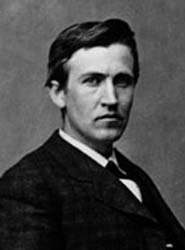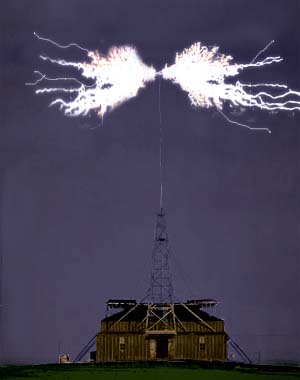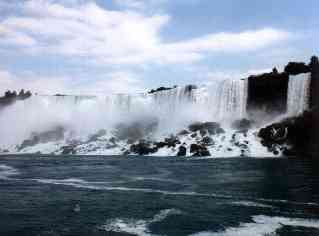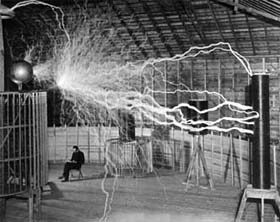|

Nikola
Tesla at age thirty-seven.
|
Sorcerer
of Lightning: Nikola Tesla
He is a mysterious, almost forgotten, figure, but his
inventions in the areas of electrical motors, electrical distribution,
remote control, low and high frequency waves, radio, radar and
even death rays continue to have a major impact on science and
engineering today. He was years and even decades more advanced
than his colleagues and many argue he took to his grave knowledge
that we still struggle to discover today.
Part One: So
Many Inventions, so Little Time
It was a summer night in 1899 when Nikola Tesla,
perhaps the greatest electrical genius of his time, emerged
from his Colorado Springs laboratory to observe the first major
test of what he would later call "my greatest invention."
From outside the square barn-like building he could see a wooden
tower eighty feet in height from which a 142-foot metal mast
emerged. At the very top of the mast was a three-foot copper
ball.
An earlier test, lasting only one second, had
confirmed that the equipment in the building, an enormous "tesla
coil" and the tower seemed to work. Now would come the
full test. Neither Tesla nor his assistant was exactly sure
what would happen - giant sparks? fire? explosion? - but they
were ready to take the risk. Others had been warned: Outside
the laboratory grounds were signs posted "KEEP OUT - GREAT
DANGER" and over the door of the building was a quote from
Dante's Inferno: "Abandon hope all ye who enter here."
When Tesla was ready, he shouted to his assistant,
Czito, "Now! Close the switch!" Czito had been instructed
to keep the machine running until Tesla told him to turn it
off. Inside the building the massive switch was thrown and outside
fireworks started to take place.
A heavy current raced through the primary coil
of the machine and lightning bolts started to explode from the
mast. Tesla watched as giant electrical sparks 135-feet long
jumped from the large copper ball. They generated a thunder
that could be heard 15 miles away. Tesla was so enthralled with
the display that he lost all track of time.
Suddenly the lightning stopped. Teslas snapped
out of his trance and raced into the building yelling, "Why
did you do that? I did not tell you to open the switch. Close
it again quickly!"
His assistant shook his head. He hadn't turned
off the current. The power company was no longer sending it.
A quick call to the power station revealed the
trouble. In the one minute it had been operating, Tesla's machine
had overloaded the powerhouse generator, setting it on fire.
The town of Colorado Springs was in a blackout and Tesla himself
would have to take a team of trained workmen to the station
to fix the dynamo. Even so, Tesla knew his new invention, his
"resonate transformer," really worked.
Early
Life
Nikola Tesla was born in 1856 in a mountainous
area of the Balkan Peninsula that was then part of the Austro-Hungarian
Empire. His parents were Serbian. His father, an Orthodox priest,
was a writer and poet. His mother had mechanical aptitude and
invented many appliances to use around the household and farm,
including an eggbeater.
Tesla was such a brilliant mathematician in school
that he performed integral calculus in his head, a skill that
left his teachers thinking he must be cheating. While still
at school he decided he wanted to become an engineer. This was
a career which conflicted with his father's desire for Tesla
to follow him into the priesthood. In the end, Tesla won the
battle and was enrolled in the Austrian Polytechnic School at
Graz.
While studying electrical and mechanical engineering
Tesla was shown the newly-invented Gramme dynamo that could
be used both as a electrical motor and a generator. He studied
it and observed to his teacher that there should be some way
of doing away with the inefficient sparking connector on the
device. His professor was skeptical, but Tesla was right. Over
the next few years Tesla would come up with the idea of alternating
the current flow (known as AC) to solve this problem. In the
end, this idea would underlie the design of every commercial
electrical system throughout the world.
Tesla was hired by firms in Germany and France
to improve their direct current (DC) generation facilities,
but neither was interested in his radical AC designs. It became
apparent to him that he would have to take his inspiration to
someone who could really appreciate it. To the greatest electrical
engineer of the day, the renowned "Wizard of Menlo Park,"
Thomas Alva Edison.
After getting a letter of introduction from one
of Edison's European business partners, Charles Batchelor, Tesla
took a ship to New York City. At the age of 28 he was off to
see the Wizard.
Tesla and Edison
Arriving at Edison's office Tesla presented him
with the letter of introduction from Batchelor. In part it read:
My Dear Edison, I know two great men and you
are one of them. The other is this young man!
|

Thomas
Alva Edison
|
Testla proceeded to explain his work and his idea
for alternating current. Edison wasn't interested. Edison already
had an enormous amount of money invested in his own DC system
and didn't want to change. He did recognize that this young
man from Europe was very talented and offered to hire him, promising
him $50,000 if he could make certain improvements in his DC
generation plants.
Despite both being genius inventors, Tesla and
Edison had very different styles. Edison was largely self-taught,
while Tesla had a formal European education. Edison discovered
by trial and error, a method he expressed best in his famous
saying, "Invention is five percent inspiration and 95 percent
perspiration." Tesla preferred to think about an invention
and would only build the actual model when he had it all worked
out in his mind. Tesla's thinking was so precise that the first
model would almost always work the way he expected with no alterations.
Tesla once said of Edison:
If Edison had a needle to find in a haystack,
he would proceed at once with the diligence of the bee to examine
straw after straw until he found the object of his search..
I was a sorry witness of such doings, knowing that a little
theory and calculation would have saved him ninety per cent
of his labor.
It wouldn't be long before the men would clash.
Just a few months after starting, Tesla finished his improvements
and went to Edison to get his $50,000. Edison, who probably
thought that what he had sent Tesla to do an impossible job,
refused to pay, saying that the offer had not been meant to
have been taken seriously. "When you become a full-fledged American,
you will appreciate an American joke," Edison quipped.
Disgusted, Testla resigned and soon got involved
with investors who wished to build an improved arc lamp. They
founded the Tesla Electric Light Company. His design
was a success, but all the money went to the investors. Tesla
was soon looking for another opportunity.
It came in the form of A.K. Brown of the Western
Union Company. Brown agreed to invest in Tesla's idea for an
AC motor. In a small laboratory not far from Edison's office,
Tesla developed all the components necessary for an AC generation
and distribution system along with his AC motor. Late in 1887
Tesla filed for seven U.S. patents on his AC systems. The inventions
were so unique that they were issued without a successful challenge.
The
War of the Currents
George Westinghouse, inventor of railroad air
brakes, heard about Tesla's system and visited him at his laboratory.
After viewing the inventions, Westinghouse paid $60,000 for
the patents, which included $5,000 in cash and 150 shares of
stock in the Westinghouse Corporation. Westinghouse then used
Tesla's AC system to challenge Edison's DC system for the future
of electrical distribution within the United States.
|

Artist
conception of Teslas' resonant transformer in action.
|
The AC system was clearly superior. In order to
send electricity any distance, it must be at very high voltages.
The voltage in an AC system could be stepped up or down to different
voltages very easily with a device called a transformer. Transformers
were not available for DC at that time, which meant that DC
power couldn't be sent more than a few blocks because lower
voltages needed to be used in homes. A DC system like Edison's
might require a power plant within a few blocks of every house,
instead of a single power plant for the whole city.
Edison, ignoring this, started a full scale propaganda
campaign against Westinghouse, Tesla and AC current. He hired
a man by the name of Harold Brown to go around the country and
demonstrate how AC was more dangerous than DC (something that
wasn't necessarily true) by staging shows where he electrocuted
dogs and old horses. Brown referred to this process as being
"Westinghoused." Brown even managed to buy a used
Westinghouse generator and get it hooked up to the world's first
electric chair at New York's Auburn State Prison so that AC
would be associated with electrical executions.
Despite the smear tactics employed by Edison,
it became clear that the AC system had many advantages. In 1892
the Chicago World's Fair was lit entirely with AC power coming
from twelve thousand-horsepower AC generation units located
in the fair's Hall of Machinery. Competitors had bid a DC system
for the fair, but lost the job because the huge amount of copper
needed for such a DC system (because of its low effiencey) was
too high.
As Westinghouse started winning the war, Edison
was forced to merge his company with the newly formed General
Electric Corporation. General Electric would have taken control
of Westinghouse too if it hadn't been for the generosity of
Tesla. Tesla gave up control of AC patents worth millions of
dollars because he believed that an independent Westinghouse
Company was the only way his AC system would be widely adopted.
This move by Tesla ensured the future of AC, but
left him short of cash to pursue his research in the future.
Taming
Niagara Falls
As a boy Tesla had seen an engraving of the great
falls of the Niagara river and dreamed of harnessing their power.
In 1893 he actually got his chance. Lord Kelvin, the head of
the commission in charge of a project to tap power from the
falls, originally had argued against Tesla's AC system, but
changed his mind after visiting the Chicago World's Fair. Impressed,
Kelvin supported AC for the project and Westinghouse won a contract
to build a powerhouse at the falls.
|

Tesla
dreamed of taming the power of Niagara Falls.
|
Tesla designed the systems and was confident they
would work, though a project of this magnitude had never before
been done. Investors, including J.P Morgan, were nervous about
the success of the venture. The project was difficult, expensive
and took five years to complete. On November 16, 1896, when
the switch was thrown, Tesla's systems worked perfectly. One
by one each of the ten planned generators came online over a
few months. The Niagara power station generated some 15,000
horsepower of electricity, a phenomenal amount for the time.
Newspaper and engineering journals agreed that,
as the New York Times put it, Tesla deserved the "undisputed
honor" of making the project possible. Lord Kelvin said
Tesla had "contributed more to electrical science than
any man up to his time."
Experimenting
with High Frequency
Back at his laboratory in New York City, Tesla
started to look into what happened with electricity when you
alternated it at extremely high frequencies. At first he tried
altering one of his AC generators to do this, but the machine
flew apart when it reached twenty thousand cycles (alterations)
per second. To go further he had to invent a new device. Dubbed
the "Tesla coil," it could take normal household current
(60 cycles a second) and step it up to thousands of cycles per
second. The coil could also generate extremely high voltages.
Testla thought that high frequency electricity
would have many advantages: Lamps would give out more light,
electricity would travel more efficiently through wires, and
systems would be safer because high frequency electricity passed
across the surface of a person's body rather than through it.
Using this technology, Tesla tried to make better
and brighter lamps than the incandescent bulbs Edison had marketed
so successfully. In incandescent lamps, only about 10 percent
of the energy it uses comes out as light. Tesla hoped he could
find a better solution. His work resulted in the first neon
and fluorescent lights ever made. It was during this phase of
his experimentation that he discovered that he could make a
lamp light with no wires attached to it at all just by using
high frequency electricity that would pass through air. The
effect would eventually be known as radio transmission.
By using a Tesla coil tuned to the same frequency
as another Tesla coil sending energy, Tesla realized that he
could send signal through thin air. He was about to demonstrate
this in 1895 by sending a signal 50 miles to West Point, New
York, when his lab caught fire and burned down. For this reason
he didn't get to file a patent on the system until 1897. Unfortunately,
an Italian inventor, Guglielmo Marconi, had filed a patent in
England in 1896 for a less capable system. As Marconi worked,
at first Tesla was unconcerned about his progress saying, "Marconi
is a good fellow. Let him continue. He is using seventeen of
my patents", but later a fight broke out between the inventors
over who had first invented radio. The fight would became particularly
bitter when Marconi won the Nobel prize for the invention in
1911. Marconi's first American patent application, made in 1900,
was denied because of Tesla's earlier patent, but later the
U.S. patent office reversed its decision, giving a patent to
Marconi. It wasn't until 1945, two years after Tesla's death,
that American courts upheld Tesla's patent and his claim to
the invention of radio.
Robotic
Boat
From radio signals it was only a short hop in
Tesla's agile mind to radio remote controls. In 1898 at an electrical
exhibition in Madison Square Garden, Tesla had a small indoor
pond built and into this pond he placed a strange iron-hulled
boat that looked like a small bathtub with a lid. By using radio
signals, Tesla was able to control the boat's motor, sending
it zipping around the pond seemingly under its own control.
He even installed lights on it he could blink at a distance
from his control box. Many observers, unfamiliar with radio
waves, thought that the device must have a brain of its own
or that somehow Tesla was controlling it with his mind. When
it was first shown "it created a sensation such as no other
invention of mine has ever produced," Tesla would later write.
Tesla called the object a "teleautomaton"
and thought of it as the first of many robotic inventions that
would serve mankind. When a reporter suggested that such a boat
might be made to carry an explosive charge and used as a weapon
of war, Tesla grew angry. "You do not see there a wireless
torpedo, you see there the first of a race of robots, mechanical
men which will do the laborious work of the human race."
Wireless
Power
|

Tesla
sits in his laboratory while his lightning strikes around
him in this trick photograph.
|
Tesla's experiments with radio convinced him it
was possible to send not only electrical signals through the
air, but power. Conditions for this would be best at high altitudes
where the air was thin. Knowing this, Tesla's patent lawyer
and friend Leonard E. Curtis, suggested that Tesla might set
up a new laboratory near mile-high Colorado Springs, Colorado.
Curtis owned part of the El Paso Power Company located there
and could get him free electricity for his experiments.
Tesla spent a year at the site in Colorado testing
and experimenting with his "resonate transformer."
The results convinced him it was possible to send power through
the air. In the spring of 1900 he packed up his Colorado laboratory
and returned to the East coast, determined to bring the world
a new way to get electrical power.
To be continued in part two: Power
Through the Air

Copyright Lee
Krystek 2002. All Rights Reserved.